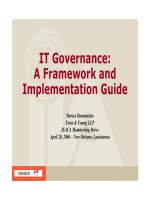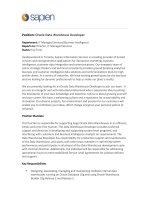Tài liệu Large-Scale MPLS VPN Deployment pdf
Bạn đang xem bản rút gọn của tài liệu. Xem và tải ngay bản đầy đủ của tài liệu tại đây (20.46 KB, 4 trang )
4
Large-Scale MPLS VPN
Deployment
4-2 Large-Scale MPLS VPN Deployment Copyright 2000, Cisco Systems, Inc.
MP-BGP Scalability Mechanisms
Review Questions
n Describe BGP scaling issues in a MPLS VPN network.
The number of routes in a very large MPLS/VPN network may result in
exceeding the resources of the PE routers.
MPLS VPN uses internal BGP to propagate VPNv4 routes,
experiencing the same scaling limitations as known in a traditional BGP
networks.
n Describe built-in MP-BGP scalability mechanisms.
The most recent IOS releases provide the automatic route filtering of
incoming MP-BGP updates.
A bit modified BGP route refresh feature, requesting a resend of all
VPNv4 MP-BGP routes from its neighbor.
The outbound route filters (ORF) carried in the BGP route-refresh
messages, imposing the sending router to discard routes prior to sending
them to the receiving router.
n Why does the automatic filtering of inbound VPNv4 updates increase MPLS
VPN scalability?
A PE router does not keep routing information for VPNs not connected
it.
n What are the implications of automatic inbound filtering on BGP route-reflector
design?
RRs do not filter anything because they forward routing information to
other PE routers.
n Why do you need route-refresh functionality?
You need this functionality to minimize the volume of BGP traffic after a
change in routing policy. Router can request a resend of BGP updates
from its neighbors, instead of storing extra copies of neighbor BGP
routes.
n When would a router send a route-refresh request to its neighbors?
In case a new VRF is configured on the PE router and the update that
was previously ignored is now needed to gain connectivity for this new
VRF.
n What is an outbound route filter (ORF)?
ORFs are used to further minimize the number of updates by uploading a
filter to the neighbor.
n Why are outbound route filters useful?
Copyright 2000, Cisco Systems, Inc. Release Date: October 2000 4-3
They are used by the receiving PE router to make sure that the sending
PE router will discard all the routes that would be discarded by the
receiving router, prior to sending the information to the receiving router.
4-4 Large-Scale MPLS VPN Deployment Copyright 2000, Cisco Systems, Inc.
Partitioned Route Reflectors
Review Questions
n What is the basic function of partitioned route reflectors?
The segmentation of VPNv4 information
n What are the benefits of partitioned route reflectors?
Increasing the scalability
Each independent route reflectors stores only a portion of overall VPNv4
routing information
n Why are partitioned route reflectors needed in very large MPLS VPN
backbones?
To increase the scalability of the network
n How can you implement partitioned route reflectors?
By using filters based on standard BGP communities.
By using the bgp rr-group command on the RR to utilize the ORF
functionality.
By using filters based on extended BGP communities.
n What are the benefits of using bgp rr-group functionality?
Simple configuration.
Optimized propagation of updates (ORF functionality is used).
n Why would you choose implementation based on standard BGP communities?
In many cases the PE routers have to attach standard BGP community
to the VPNv4 route anyway, therefore the outbound filtering based on
the standard BGP community does not represent an additional
maintenance burden.
n Why would you choose bgp rr-group implementation?
With the bgp rr-group command, the route-target based filter can be
downloaded as an outbound filter to the PE routers through the ORF
functionality.
The bgp rr-group command applies to all BGP neighbors, introducing
configuration consistency.









